QuestionHELLO, I'VE JUST PURCHASED A YELLOW 9 WEEK OLD LAB, HE IS REPLACING A BLACK LAB I HAD FOR OVER 10 YEARS, MY YELLOW LAB IS AN OUTSIDE DOG W/PLENTLY OF YARD TO EXERCISE, HE HAS A DOZEN CHEW TOYS(NOT INCLUDING FAMILY SHOES/SLIPPERS), I SPEND ALOT OF TIME W/HIM AS DO MY TWO KIDS, AGE 9 AND 11, I WALK HIM ABOUT EVERY NIGHT AFTER DINNER, I KNOW HE UNDERSTAND SOME THINGS LIKE HE CANT COME IN THE THE HOUSE OR IS NOT ALLOWED IN THE FRUIT GARDEN, THE FIRST PROBLEM IS: HE KEEPS TRYING TO BITE YOUR HANDS/FINGERS WHEN YOU PET HIM OR ATTEMPT TO PET HIM, EVEN AFTER STERN "NO BITE" COMMAND, HE CONTINUES TO BITE, THESE ARE NOT VISIOUS BITES, JUST FRIENDLY BITES, BUT HIS LITTLE TEETH ARE VERY SHARP AND EVERYBODY'S TIRED OF LITTLE HOLES IN THEIR CLOTHING, THE SECOND PROBLEM IS: WHEN YOU ASK HIM TO "COME HERE" AS TO PET HIM OR TO ATTACH A LEASH TO HIS COLLAR, HE BACKS UP AND RUNS THE OTHER DIRECTION, BUT AT TIMES WHEN YOU CALL HIS NAME FROM THE OTHERSIDE OF THE HOUSE/YARD, HE WOULD COME/RUN OVER TO YOU, IS THESE PROBLEMS NORMAL AND WILL IT EVENTUALLY PAST AS HE GETS OLDER, CAN YOU PLEASE GIVE ME ANY ADVISE TO MY PROBLEMS, THANK U MANY DOGGY LICKS, GLENN, TIGERS MASTER.
AnswerYoung Labs, which I know best, and other puppies tend to very bad about
biting. You see a litter of them, and all the ones that are awake are biting
another one or themselves. I am not even sure they realize that when they are
alone, if they quit biting, they would quit being bitten. At 3 to 4 months
they are getting their adult teeth, and it seems they spend every waking
moment biting or chewing. I maintain a Lab's favorite chew toy is another
Lab. Otherwise they settle for any person they can. They keep hoping to find
one that won't yelp and jerk their hand away, or growl "Bad dog." and clamp
their mouth shut. Then offer a chew toy. They keep trying despite hundreds
of corrections. Another good technique is to quit playing and go away. Be
sure to praise them when they are playing nice and not biting.
You just have to keep on correcting them, hundreds of times, not dozens.
Provide sturdy, safe toys such as Kongs and Nylabones. Avoid things they can
chew pieces off and choke on them. Keep them away from electrical cords.
Crates are essential for most young Labs and other dogs.
The pet stores are full of toys that many dogs will quickly chew up into
pieces they could choke on or cause intestinal blockages. If you are not
there to watch, stick to sturdy stuff such as Nylabones and Kongs. Keep a
close eye on chew toys and quickly discard anything that is coming apart in
pieces. Rawhide is especially bad because it swells after being swallowed.
These problems are the worst with, but not limited to, large, aggressive
chewers such as Labs.
"Come" needs to be taught as part of proper pack status and obedience. The
dogs see all the people and dogs in the household as a pack with each having their
own rank in the pack and a top dog. Life is much easier if the 2 legged pack
members outrank the 4 legged ones. You can learn to play the role of top dog by
reading some books or going to a good obedience class. Start at
http://www.dogsbestfriend.com/
Before 4 months use a conventional flat collar to protect the tender young neck.
When your dog is at least 4 - 5 months old, switch to a good 6' leather leash and
a sturdy slip collar, the metal chain
ones with the rings on each end. You want the shortest one that will go on
and off easily. If you walk with the dog on the left, pull the chain through
one loop forming a "P". Facing it, slip it over its head. The free end
should come over the neck to the leash, and the other end should drop slack
when there is no pull on the leash.
With the dog at the end of the leash, call its name and "Come" in a firm
voice. If it comes, praise it lavishly and pet it. If it doesn't come, repeat
the command and give the leash a light snap. Keep it up with firmer leash snaps
until the dog does come. Do not forget the praise. Then switch to a longer
leash or rope, about 25'. When it comes well on the longer leash, you should
be able to go to
off leash in a fenced area, etc. Once the dog is doing well, introduce come,
treat. This is for emergencies only when the dog has gotten loose accidentally.
Use it routinely and you will have nothing to fall back on when your dog is
headed for a busy street. "Name, come treat!" is little different from the
regular "Name, come!", except the dog gets a great treat when it comes. We are talking a hot dog, cheese, etc. much better than any treat you use routinely.

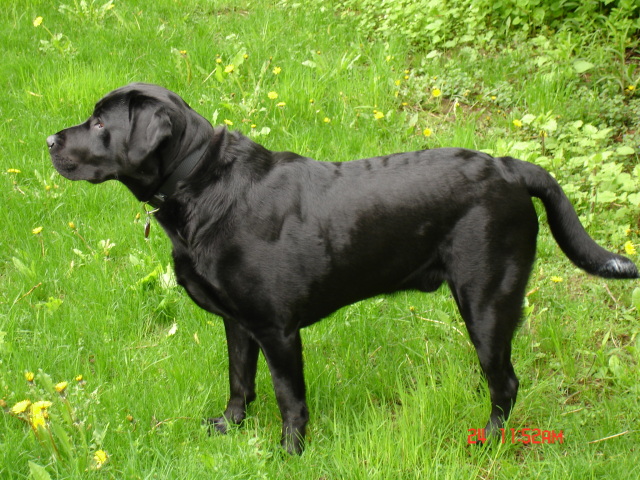 shedding, size, uncontrolled around other dogs
Question
Sawyer
My 13 month old black lab is shedding u
shedding, size, uncontrolled around other dogs
Question
Sawyer
My 13 month old black lab is shedding u
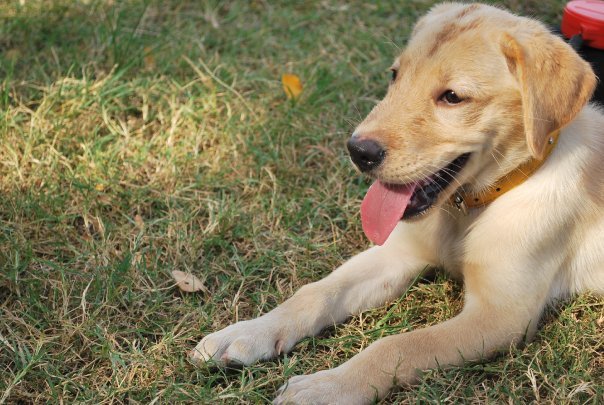 vitamins for my yellow lab
Questionbruno
QUESTION: what is the best vitamin
vitamins for my yellow lab
Questionbruno
QUESTION: what is the best vitamin
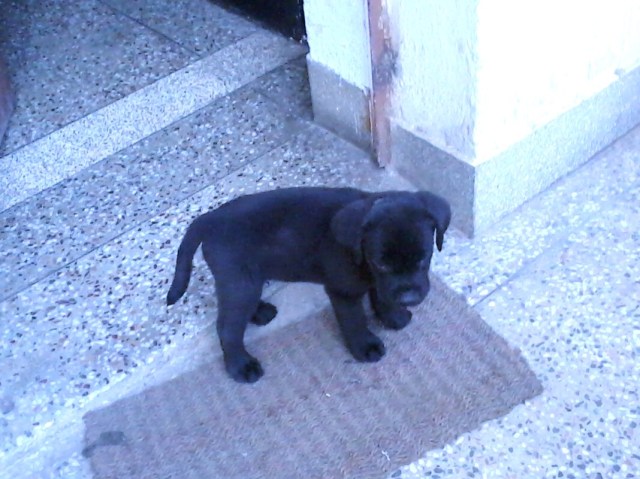 labrador diet
Question
striker
i have a black male Labrador of 4 mont
labrador diet
Question
striker
i have a black male Labrador of 4 mont
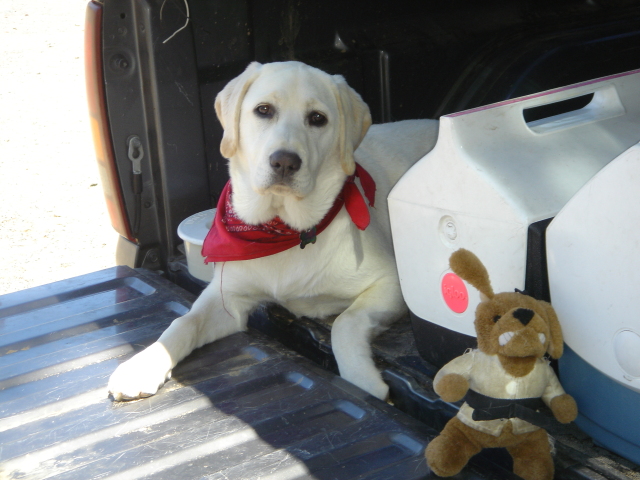 Diet
Question
Lucy and her toy
My yellow lab is about 1 year
Diet
Question
Lucy and her toy
My yellow lab is about 1 year
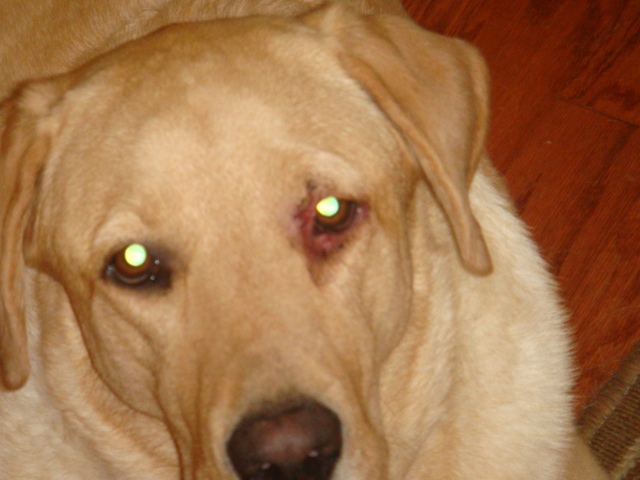 pink rim around eye
Question
his eye
i have a pure yellow lab and hes 3 yrs
pink rim around eye
Question
his eye
i have a pure yellow lab and hes 3 yrs